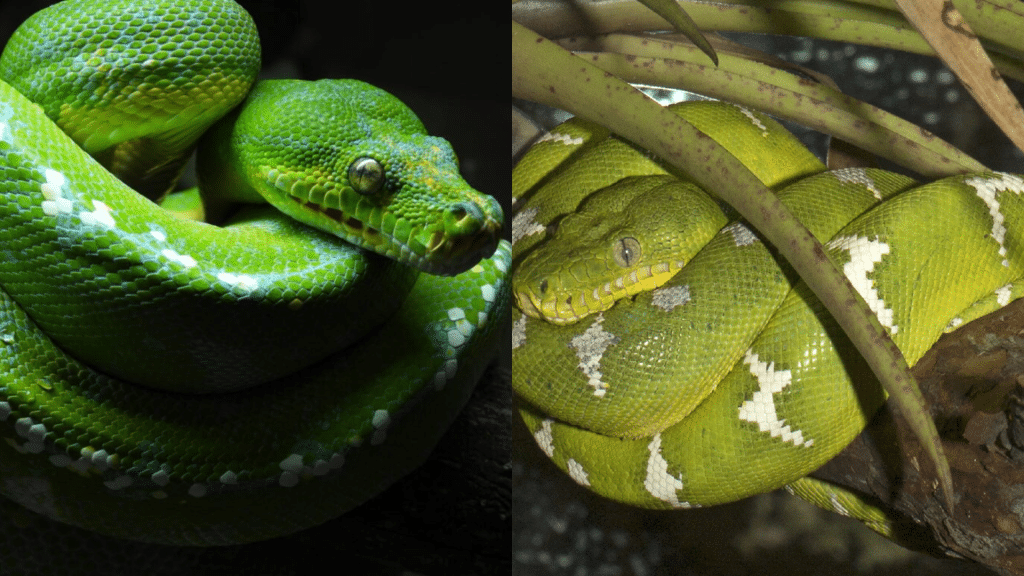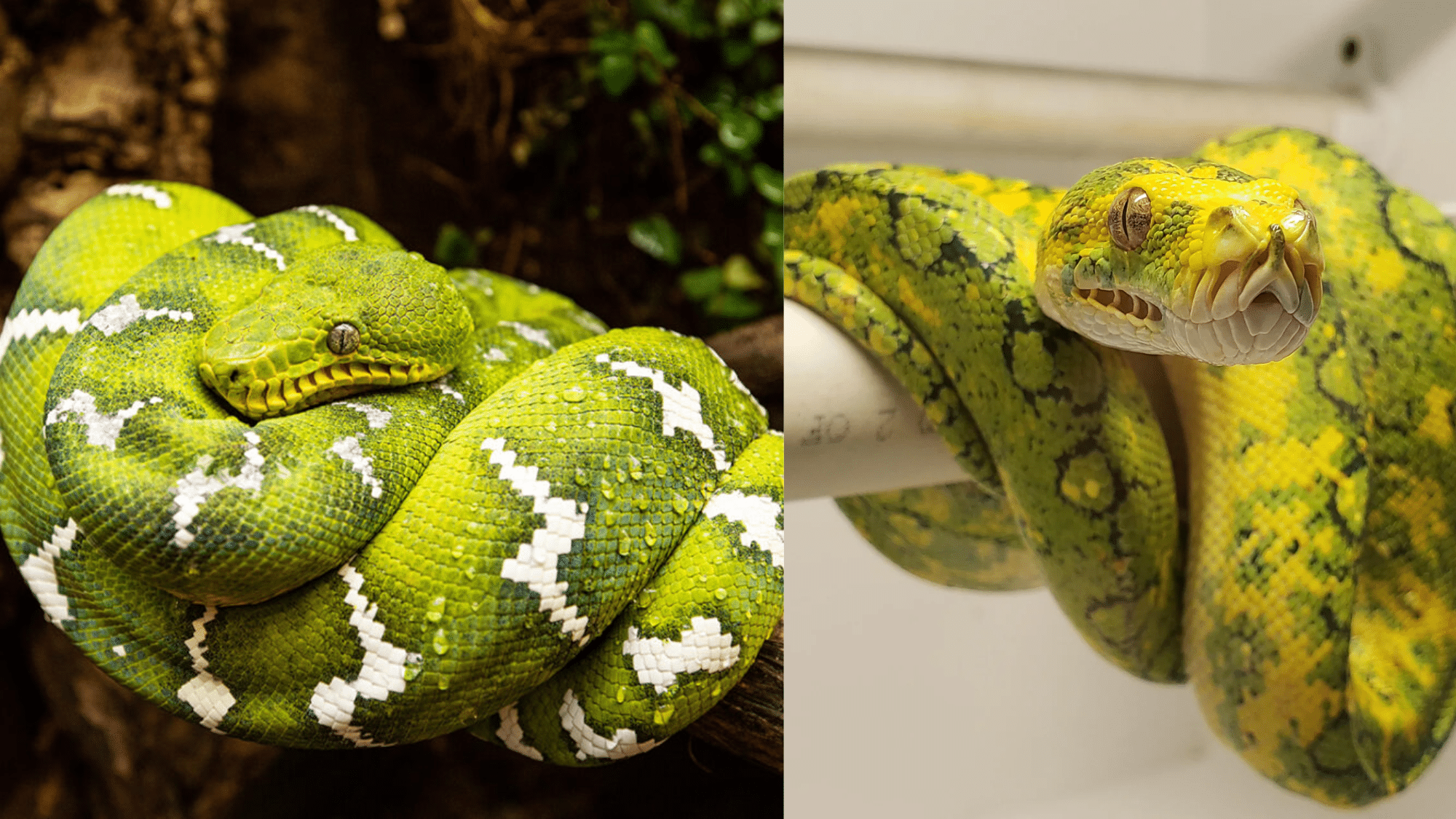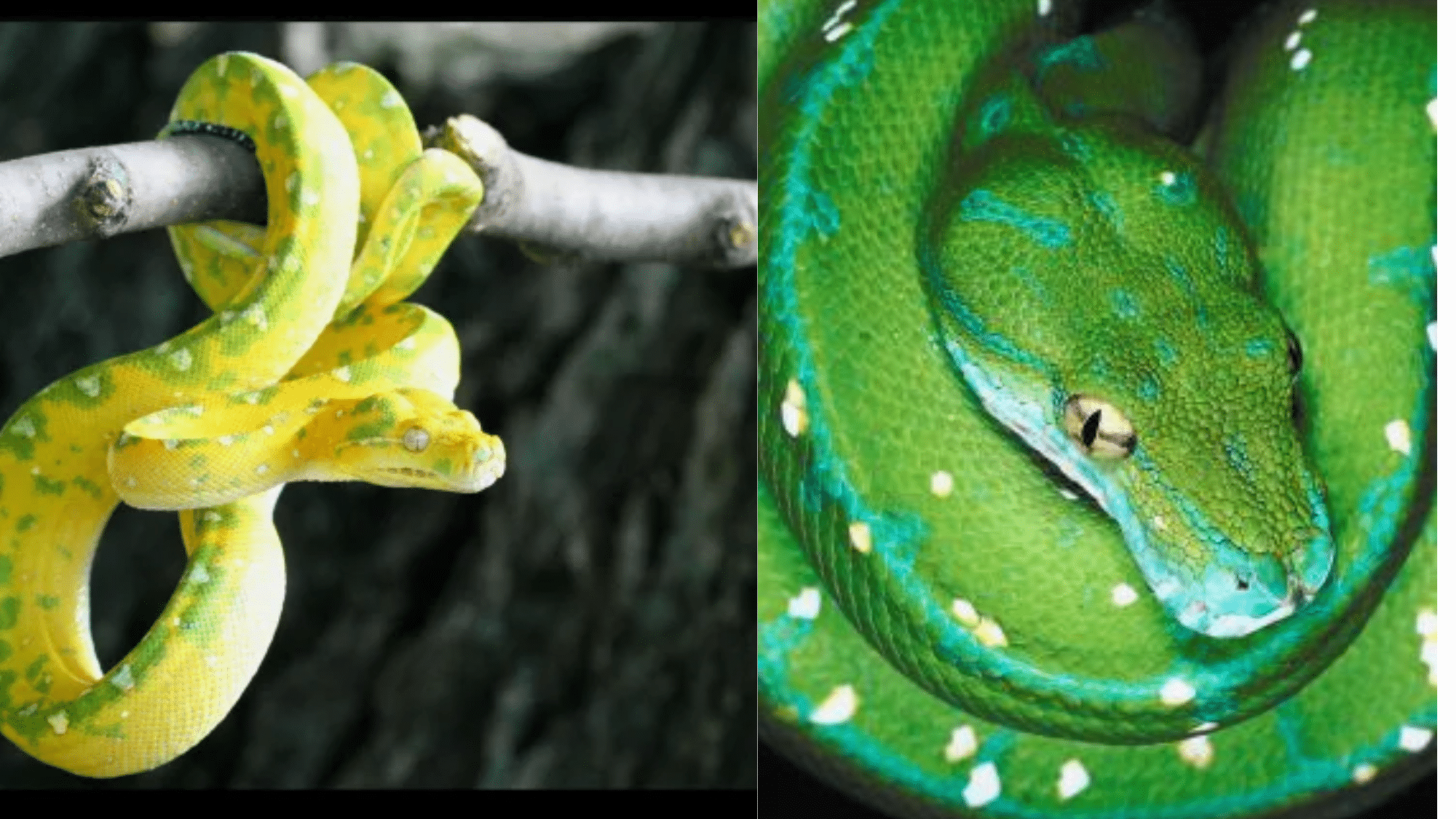Can two snakes from opposite sides of the world look almost identical by chance?
Well, the emerald tree boa and green tree python present one of nature’s most curious cases of look-alikes.
With their striking green bodies coiled perfectly around branches, even experts sometimes pause before telling them apart.
What caused these snakes to develop such similar features despite living oceans apart?
As you read on, you’ll find out how these snakes developed their remarkable similarities and the hidden details that set them apart.
Origins and Evolution of These Snakes
The emerald tree boa and green tree python underwent a remarkable change in nature. These snakes developed similar traits despite living thousands of miles apart.
The emerald tree boa is found in the lush forests of South America. It belongs to the Corallus genus and has been present in the Amazon Basin for millions of years.
Meanwhile, the green tree python lives in Australia and New Guinea. This snake belongs to the Morelia genus and is related to carpet pythons of the region.
The trees and hunting needs in both locations prompted these snakes to develop similar appearances and behaviors.
However, their tree-dwelling lifestyle required specialized features, which both species created separately over time.
Physical Characteristics and Their Differences
| Feature | Emerald Tree Boa | Green Tree Python |
|---|---|---|
| Size | 4 to 6 feet long | 4 to 5 feet long |
| Body Structure | Thicker body, more defined head | Slightly slimmer body, less pronounced head |
| Markings | White zigzag patterns like lightning bolts | Yellow or white scattered spots |
| Head Shape | More triangular with large heat-sensing pits | Rounder snout with smaller heat pits |
| Baby Coloration | Reddish-orange at birth | Yellow, red, or brown at birth |
| Eyes | Yellow eyes with vertical pupils | Darker eyes (brown or amber tones) |
| Teeth Position | Front-facing teeth | Inward-facing teeth |
Behavioral Pattern of These Snakes
How do these green tree-dwelling snakes create the next generation?
Well, the emerald tree boa and green tree python take surprisingly different paths when bringing new life into the world.
Birth Methods: Live Babies vs. Eggs
| Species | Reproductive Method | Gestation Period | Number of Offspring | Characteristics of Young | Additional Notes |
|---|---|---|---|---|---|
| Emerald Tree Boa | Viviparity (live birth) | 6-7 months | 5-12 | Fully formed, bright reddish-orange color | No eggshells; young resemble mini versions of the mother |
| Green Tree Python | Oviparity (egg-laying) | 45-60 days (incubation) | 6-30 | Yellow or red scales on hatchlings | The female wraps around the eggs to protect and regulate temperature |
The Dating Game: During mating season, males of both species become surprisingly active. These normally sedentary snakes will travel considerable distances, following scent trails left by receptive females.
Once the brief courtship ends and mating occurs, these snakes go their separate ways no long-term relationships in the tree python world.
From Birth to Adulthood: Baby emerald tree boas and green tree pythons face the world alone from day one. Neither mother provides parental care after birth or hatching.
The young must rely purely on built-in instincts to hunt small lizards and avoid becoming meals themselves.
As they grow, their colorful baby scales gradually transform into the distinctive green that helps adult snakes blend in among the leaves.
The Clock Keeps Ticking: These remarkable snakes enjoy lengthy lifespans when properly cared for. Emerald tree boas often reach 20-25 years of age, while their green tree python counterparts typically live 15-20 years.
Their slow-motion lifestyle, characterized by periods of inactivity lasting days between meals, contributes to their longevity.
Dietary Habits: What They Hunt and Eat
The dietary preferences of these two snake species reveal both similarities and subtle differences in their hunting approaches.
Their body systems slow down between feedings, allowing them to use energy very efficiently while waiting for the next meal to come within striking distance.
What The Emerald Tree Boa Eats:
- Small mammals form the bulk of their diet – rodents and bats are favorites
- Birds that come too close to their perch become meals
- Lizards and tree frogs serve as backup options when other prey is scarce
- Adult snakes sometimes tackle larger prey like squirrels and opossums
What The Green Tree Python Eats:
- Small mammals, including rats and possums, make up most meals
- Birds that land nearby quickly become targets
- Lizards and skinks supplement their diet
- Young snakes often start with lizards before graduating to mammals
Their Shared Hunting Style:
- Both use a patient “sit and wait” approach to catching food
- They position themselves on branches with their heads hanging downward
- These hunters can remain perfectly still for hours or even days
- Heat-sensing pits help them detect warm-blooded animals passing by
An interesting fact: These snakes can go weeks or even months without eating after catching a substantial meal.
Conservation Status of These Snakes
| Species | Conservation Status | Threats | Protection Efforts |
|---|---|---|---|
| Emerald Tree Boa | Least Concern (IUCN) |
|
|
| Green Tree Python | Least Concern (IUCN) |
|
|
How to Care for Them as Pets?
Thinking about bringing one of these green tree-dwellers into your home? Here’s what potential owners should consider before making a decision.
1. The Perfect Home
These forest natives need tall spaces that mimic their natural habitat. Your snake will spend most of its time above ground, so vertical space matters more than floor area.
- Minimum enclosure size: 3 feet high by 2 feet wide by 2 feet deep
- Strong, sturdy branches at various heights for perching
- Real or high-quality fake plants for hiding and humidity
- Secure locking mechanism to prevent escape
- Smooth interior walls to protect the snake’s scales
2. Specific Climate for Survival
Think warm and steamy. These snakes thrive when the air feels like a tropical morning. Without proper temperature and humidity control, they quickly develop health issues.
- Daytime temperature: 82-88°F
- Nighttime temperature: 75-80°F
- Humidity level: 70-90%
- Daily misting is required to maintain moisture
3. Feeding Cycles as Pets
Feeding these tree-huggers follows a simple pattern: offer properly sized rodents and then wait, often for weeks. Their slow metabolism means they typically consume much less food than many pets.
- Young snakes eat every 7-10 days
- Adults may go 2-4 weeks between meals
- Always feed pre-killed prey
- Food size should never exceed the widest part of the snake
- Some snakes refuse food for months when settling into new homes
4. Hands Off Policy
These aren’t cuddle pets. Both species prefer to be observed rather than handled, and excessive contact can harm them.
- Green tree pythons tolerate occasional handling better than emerald tree boas
- Support the entire body when moving the snake
- Limit handling sessions to 5-10 minutes
- Some individuals never accept handling
- Watch for stress signs: tightening coils, hissing, or defensive postures
5. Financial Commitment
Be prepared for significant startup costs and ongoing expenses to maintain your snake’s health and comfort.
- Snake purchase: Emerald tree boas are around $350–$4,000+, depending on locality and
- Green tree pythons are typically $500–$2,500, with rare morphs exceeding this range
- Complete setup: $500-1000
- Ongoing costs include electricity, food, and substrate changes
- Exotic vet visits can cost $75-200 per visit
- Expect a 15-25 year commitment
These snakes reward their keepers with stunning beauty and fascinating behaviors, but they demand respect for their specific needs and natural tendencies.
Conclusion
Both the emerald tree boa and green tree python show how nature can create similar solutions in different parts of the world.
Their story helps to explain how animals adapt to their surroundings over time. For snake enthusiasts, recognizing the subtle differences in head shape, markings, and behavior enables them to distinguish between species with practice.
So, the next time you spot a bright green snake on a branch, you will know which one it is.






















